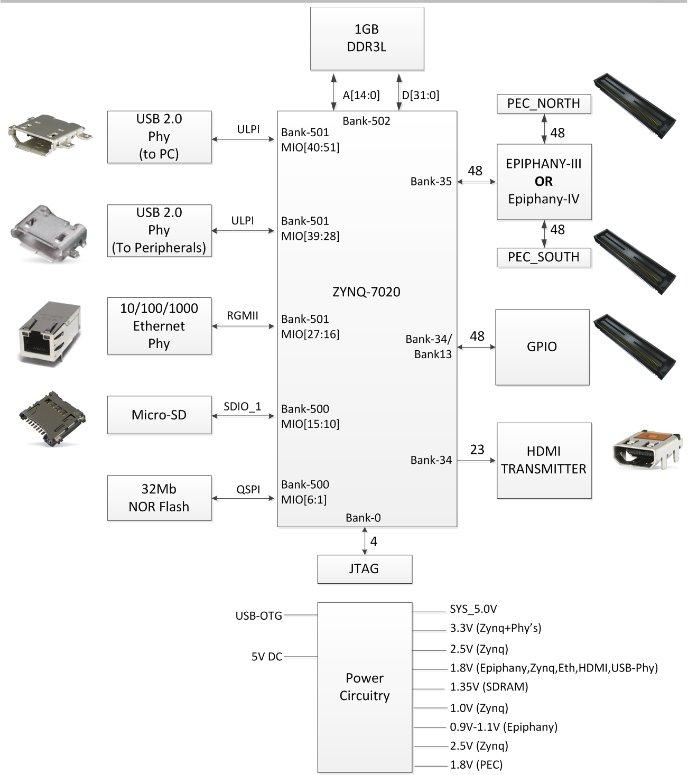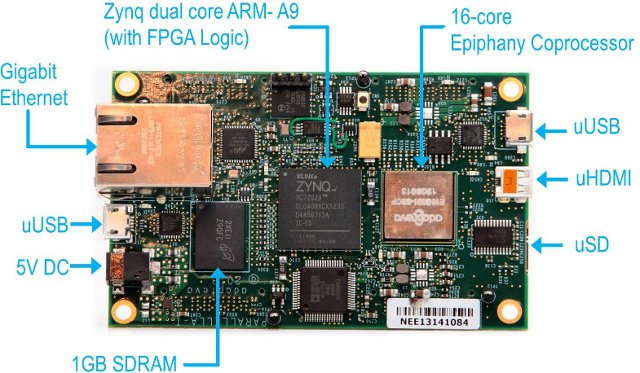Parallella is a low cost supercomputer designed by Adapteva using Xilinx Zynq-7010/7020 FPGA+2x Cortex A9 SoC combined with Adapteva Ephipany 16 or 64 cores epiphany coprocessor. The project had a successful kickstarter campaign which allowed then to provide the 16-core version for $99, and the 64-core version for $750. The board will soon be shipped to people who pledged on kickstarter, and one of the promise of the campaign was to fully open source the platform, and today, they just fulfilled that.
Before going into the details of the open source release, let’s have a look at the specs:
- SoC – Xilinx Zynq7000 Series (Z-7010 or Z-7020) Dual-Core ARM Cortex A9 with 512KB L2 Shared Cache
- Coprocessor – Epiphany Multicore Coprocessor. The Parallella-16 board includes the 16-core Epiphany-III processor The Parallella-64 board includes the 64-core Epiphany-IV processor
- System Memory – 1024MB DDR3L
- Boot Flash – 128 Mb QSPI Flash
- Indicators – 2 User controlled LEDs
- USB:
- USB 2.0 Port(0) Connects to a host machine (PC/tablet/smartphone)
- USB 2.0 Port (1) Connects peripheral devices
- Ethernet – 10/100/1000M Ethernet, RJ45 with magnetics and LEDs
- SD Connector – MicroSD, 3.3V
- Video – Micro HDMI connector
- Expansion Connectors – Four 60-pin high speed Samtec connectors for:
- Epiphany link expansion connector(s)
- Zynq programmable logic extension connector
- Power, JTAG, debug connector
- Power Source – USB or 5.0V DC
- PCB Dimensions – 86.36mm x 53.34mm

The 64-core version of the Parallella computer is said to deliver over 90 GFLOPS of performance, and have a processing equivalent to a 45 GHz CPU [64 CPU cores * 700MHz] providing you can run your application on the 64-core simultaneously on a tiny board consuming only 5 Watts under typical work loads. Imaging, communications, automotive, medical, and audio applications could take advantage of parallel computing at a much lower cost than is currently available with Parallella.
In order to make a platform really “open source hardware” you need to release the source code as well as the hardware file, and for the parallela platform everything seems now available on their github repository including:
- Parallella board design files with bill of materials, schematics (dsn and pdf), layout files (brd), and Solidworks files.
- Official u-boot for Parallella board
- Official linux kernel for Parallella
- Official Ubuntu distro for Parallella
- Sourceware Tree for Epiphany
- GCC for Epiphany
- SDK scripts for Epiphany
We’ve got the hardware files, u-boot and linux for Zynq EPP, and the software running on Adapteva coprocessor. I haven’t checked the details but it looks like they fulfilled their promise. You can also access a preliminary version of Parallella Reference Manual.
You can also find more documentation on parallella.org. If you’ve missed the kickstarter campaign, and need a platform for parallel computing, the Parallela boards do not seem available right now, but you can register on their website to be informed once they are up for sale again.

Jean-Luc started CNX Software in 2010 as a part-time endeavor, before quitting his job as a software engineering manager, and starting to write daily news, and reviews full time later in 2011.
Support CNX Software! Donate via cryptocurrencies, become a Patron on Patreon, or purchase goods on Amazon or Aliexpress





